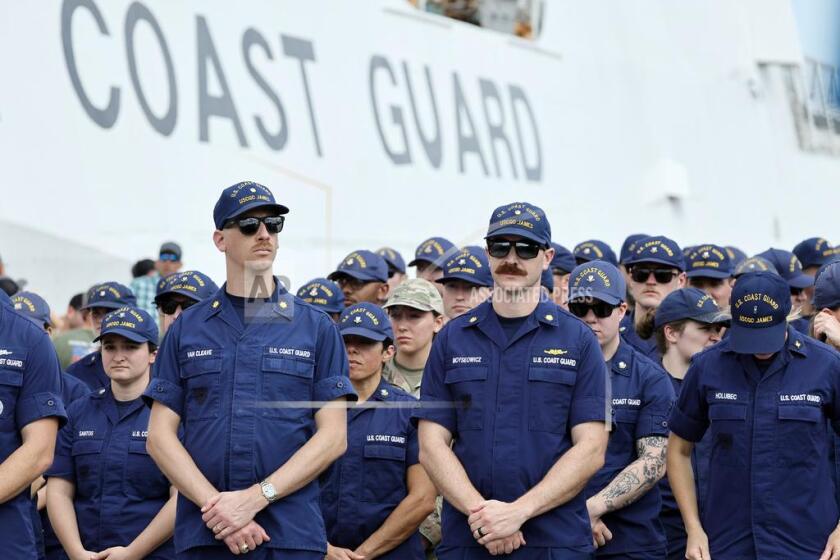U.S., Soviet Generals to Meet on Major’s Death : Shultz, Dobrynin Reach Agreement on Steps to Avert Another Incident; Nicholson Rites Held
- Share via
WASHINGTON — The United States and the Soviet Union agreed Saturday that military commanders from both sides should meet to discuss the killing of an American major by a Soviet sentry in East Germany and to consider ways to prevent such incidents.
The agreement was reached at a State Department conference between Secretary of State George P. Shultz and Soviet Ambassador Anatoly F. Dobrynin and was announced three hours before the slain officer, Maj. Arthur D. Nicholson Jr., was buried with full military honors at Arlington National Cemetery.
Emerging from the State Department meeting, Dobrynin said the 70-minute discussion with Shultz had covered the “whole range” of Soviet-American relations, from the current nuclear arms control talks at Geneva to the shooting of the 37-year-old Nicholson last Sunday.
Effort to Ease Tensions
“We agreed,” the Soviet ambassador said, “that the commander in chief of Soviet forces in Germany and the commander in chief of the U.S. Army in Europe, plus their representatives, would establish contact between themselves and discuss matters relating to this entire matter and also to consider possible measures to prevent incidents with members of the military liaison mission.”
Both sides said that the agreement was also an effort to ease tensions that followed the shooting.
R. Mark Palmer, deputy assistant secretary of state for European and Canadian affairs, told reporters that Shultz was “very pleased with the arrangement to have our commanders in chief get together to discuss this matter to ensure that there will be no repetition of such episodes.”
The Soviet ambassador made no apology for the incident, his government having steadfastly asserted that Nicholson was discovered taking photographs in a high-security area near the East German town of Ludwigslust, 80 miles northwest of Berlin.
Although Vice President George Bush on Friday described the killing as a “murder,” the incident has generally been treated with reserve by the Reagan Administration.
President Reagan himself referred to the killing as a “tragedy that never should have happened” but made it clear that he hopes it will not interfere with any possible summit meeting with Mikhail S. Gorbachev, the new Soviet leader. Concern was also expressed here in the days immediately following the shooting that Moscow might break off the Geneva arms talks.
Later Saturday, after the Episcopal funeral service for Nicholson in the chapel at Virginia’s Ft. Myer, Gen. Glenn Otis, U.S. Army commander in Europe--the officer who would meet with the Soviet commander in East Germany--walked to the nearby Arlington grave site with Nicholson’s widow, Karyn, behind the coffin drawn by six white horses.
Also walking to the grave site was Nicholson’s 8-year-old daughter, Jennifer, still carrying the Cabbage Patch doll she held when she arrived from West Germany on Friday in the C-141 transport plane that returned her father’s body. During the service, Col. Roland Lajoie, commander of the U.S. Army liaison mission, read Nicholson’s 14-year record of Army service, most of it in military intelligence as a Soviet specialist. All 14 members of the liaison mission attended the funeral in uniform, along with their British and French counterparts.
At the grave, next to the tomb of Joe Louis, the heavyweight boxing champion, and 100 yards below the mausoleum dedicated to the unknown soldiers of three wars, final prayers ended with the firing of three volleys and the playing of “Taps.” Uniformed pallbearers folded the flag which had covered the casket as an Army band played “America.” The dead officer’s father, retired Navy Cmdr. Arthur D. Nicholson, accepted the banner for the widow, wiping his eyes as he stood by the grave in his old Navy blues.
Deputy Secretary of Defense William Howard Taft IV presented the medal of the Legion of Merit to Nicholson’s widow and Army Secretary John O. Marsh Jr. awarded a Purple Heart. Together, the widow and daughter stepped forward to place a red rose and a sprig of white blossoms on the coffin, both of them remaining composed. After other family members added flowers, the mother and daughter again touched the coffin and, escorted by Otis, led the mourners to a line of waiting cars.
More to Read
Sign up for Essential California
The most important California stories and recommendations in your inbox every morning.
You may occasionally receive promotional content from the Los Angeles Times.










